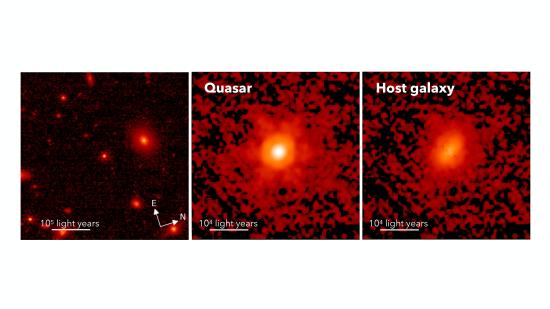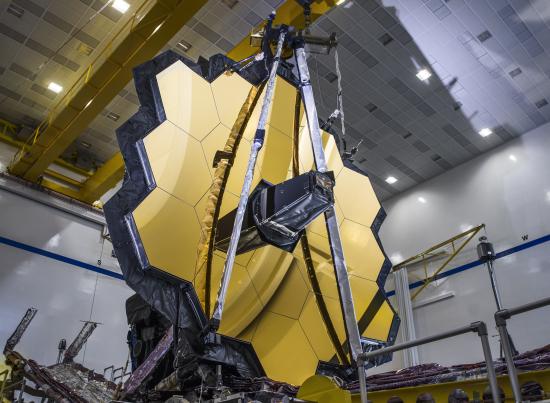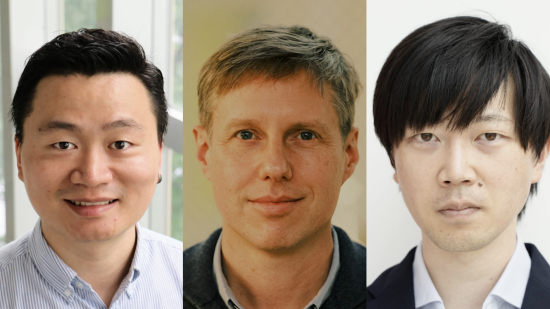29 June, 2023
Kavli Institute for the Physics and Mathematics of the Universe (Kavli IPMU)

New images from the James Webb Space Telescope have revealed, for the first time, starlight from two massive galaxies hosting actively growing black holes – quasars – seen less than a billion years after the Big Bang. A new study in Nature this week finds the black holes have masses close to a billion times that of the Sun, and the host galaxy masses are almost one hundred times larger, a ratio similar to what is found in the more recent universe. A powerful combination of the Subaru Telescope and the JWST has paved a new path to study the distant universe.
The existence of such massive black holes in the distant universe has created more questions than answers for astrophysicists. How could these black holes grow to be so large when the universe was so young? Even more puzzling, observations in the local universe show a clear relation between the mass of supermassive black holes and the much larger galaxies in which they reside. The galaxies and the black holes have completely different sizes, so which came first: the black holes or the galaxies? This is a “chicken-or-egg” problem on a cosmic scale.
An international team of researchers, led by Kavli Institute for the Physics and Mathematics of the Universe (Kavli IPMU) Project Researcher Xuheng Ding and Professor John Silverman, and Peking University Kavli Institute for Astronomy and Astrophysics (PKU-KIAA) Kavli Astrophysics Fellow Masafusa Onoue have started to answer this question with the James Webb Space Telescope (JWST), launched in December 2021. Studying the relation between host galaxies and black holes in the early universe allows scientists to watch their formation, and see how they are related to one another.

Quasars are luminous, while their host galaxies are faint, which has made it challenging for researchers to detect the dim light of the galaxy in the glare of the quasar, especially at great distances. Before the JWST, the Hubble Space Telescope was able to detect host galaxies of luminous quasars when the universe was just under 3 billion years old, but no younger.
The superb sensitivity and the ultra-sharp images of the JWST at infrared wavelengths finally allowed researchers to push these studies to the time when the quasars and galaxies first formed. Just a few months after JWST started regular operations, the team observed two quasars, HSC J2236+0032 and HSC J2255+0251, at redshifts 6.40 and 6.34 when the universe was approximately 860 million years old. These two quasars were discovered in a deep survey program of the 8.2m-Subaru Telescope on the summit of Maunakea in Hawai’i. The relatively low luminosities of these quasars made them prime targets for measurement of the host galaxy properties, and the successful detection of the hosts represents the earliest epoch to date at which starlight has been detected in a quasar.
The images of the two quasars were taken at infrared wavelengths of 3.56 and 1.50 micron with JWST’s NIRCam instrument, and the host galaxies became apparent after carefully modeling and subtracting glare from the accreting black holes. The stellar signature of the host galaxy was also seen in a spectrum taken by JWST’s NIRSPEC for J2236+0032, further supporting the detection of the host galaxy.
Analyses of the host galaxy photometry found that these two quasar host galaxies are massive, measuring 130 and 34 billion times the mass of the Sun, respectively. Measuring the speed of the turbulent gas in the vicinity of the quasars from the NIRSPEC spectra suggests that the black holes that power them are also massive, measuring 1.4 and 0.2 billion times the mass of the Sun. The ratio of the black hole mass to host galaxy mass is similar to those of galaxies in the more recent past, suggesting that the relationship between black holes and their hosts was already in place 860 million years after the Big Bang.
Ding, Silverman, Onoue and their colleagues will continue this study with a larger sample using scheduled Cycle 1 JWST observations, which will then further constrain models for the coevolution of black holes and their host galaxies. The team recently learned that they have been awarded additional time for JWST in its next cycle to study the host galaxy of J2236+0032 in much more detail.
Details of this study were published in Nature on June 28.

Paper details
Journal: Nature
Paper title: Detection of stellar light from quasar host galaxies at redshifts above 6
Authors:
Xuheng Ding (1,2), Masafusa Onoue (3,1,4), John D. Silverman (1,2,5), Yoshiki Matsuoka (6), Takuma Izumi (7,8), Michael A. Strauss (9), Knud Jahnke (4), Camryn L. Phillips (9), Junyao Li (10), Marta Volonteri (11), Zoltan Haiman (12,13), Irham Taufik Andika (14,15), Kentaro Aoki (16), Shunsuke Baba (17), Rebekka Bieri (18), Sarah E. I. Bosman (4), Connor Bottrell (1,2), Anna-Christina Eilers (19), Seiji Fujimoto (20), Melanie Habouzit (21,4), Masatoshi Imanishi (7,22), Kohei Inayoshi (3), Kazushi Iwasawa (23,24), Nobunari Kashikawa (5,25), Toshihiro Kawaguchi (26), Kotaro Kohno (27,25), Chien-Hsiu Lee (28), Alessandro Lupi (29), Jianwei Lyu (30), Tohru Nagao (6), Roderik Overzier (31), Jan-Torge Schindler (32), Malte Schramm (33), Kazuhiro Shimasaku (5,25), Yoshiki Toba (7,34), Benny Trakhtenbrot (35), Maxime Trebitsch (36), Tommaso Treu (37), Hideki Umehata (38,39), Bram P. Venemans (32), Marianne Vestergaard (30,40), Fabian Walter (4), Feige Wang (30), and Jinyi Yang (30)
Author affiliations
1 Kavli Institute for the Physics and Mathematics of the Universe (Kavli IPMU, WPI), The University of Tokyo, Chiba 277-8583, Japan
2 Center for Data-Driven Discovery, Kavli IPMU (WPI), UTIAS, The University of Tokyo, Kashiwa, Chiba 277-8583, Japan
3 Kavli Institute for Astronomy and Astrophysics, Peking University, Beijing 100871, China
4 Max-Planck-Institut für Astronomie, Königstuhl 17, D-69117 Heidelberg, Germany
5 Department of Astronomy, School of Science, The University of Tokyo, 7-3-1 Hongo, Bunkyo-ku, Tokyo, 113-0033, Japan
6 Research Center for Space and Cosmic Evolution, Ehime University, 2-5 Bunkyo-cho, Matsuyama, Ehime 790-8577, Japan
7 National Astronomical Observatory of Japan, Osawa, Mitaka, Tokyo 181-8588, Japan
8 Department of Physics, Graduate School of Science, Tokyo Metropolitan University, 1-1 Minami-Osawa, Hachioji, Tokyo 192-0397, Japan
9 Department of Astrophysical Sciences, Princeton University, 4 Ivy Lane, Princeton, NJ 08544, USA
10 Department of Astronomy, University of Illinois at Urbana-Champaign, Urbana, IL, 61801, USA
11 Institut d’Astrophysique de Paris, CNRS, Sorbonne Université, UMR7095, 98bis bd Arago, 75014 Paris, France
12 Department of Astronomy, Columbia University, New York, NY 10027, USA
13 Department of Physics, Columbia University, New York, NY 10027, USA
14 Physik-Department, Technische Universität München, James-Franck-Str. 1, D-85748 Garching bei München, Germany
15 Max-Planck-Institut für Astrophysik, Karl-Schwarzschild-Str. 1, D-85748 Garching bei München, Germany
16 Subaru Telescope, National Astronomical Observatory of Japan, 650 North A’ohoku Place, Hilo, Hawaii 96720 U.S.A.
17 Graduate School of Science and Engineering, Kagoshima University, 1-21-35 Korimoto, Kagoshima, Kagoshima 890-0065, Japan
18 Institute for Computational Science, University of Zurich, Wintherthurerstrasse 190, 8057 Zürich, Switzerland
19 MIT Kavli Institute for Astrophysics and Space Research, 77 Massachusetts Avenue, Cambridge, 02139, Massachusetts, USA
20 Department of Astronomy, The University of Texas at Austin, Austin, TX 78712, USA
21 Zentrum für Astronomie der Universität Heidelberg (ITA), Albert-Ueberle-Str. 2, D-69120 Heidelberg, Germany
22 Department of Astronomy, School of Science, Graduate University for Advanced Studies (SOKENDAI), Mitaka, Tokyo 181-8588, Japan
23 Institut de Ciències del Cosmos (ICCUB), Universitat de Barcelona (IEEC-UB), Martí i Franquès, 1, 08028 Barcelona, Spain
24 ICREA, Pg. Lluís Companys 23, 08010 Barcelona, Spain
25 Research Center for the Early Universe, Graduate School of Science, The University of Tokyo, 7-3-1 Hongo, Bunkyo-ku, Tokyo 113-0033, Japan
26 Department of Economics, Management and Information Science, Onomichi City University, Hisayamada 1600-2, Onomichi, Hiroshima 722-8506, Japan
27 Institute of Astronomy, Graduate School of Science, The University of Tokyo, 2-21-1 Osawa, Mitaka, Tokyo 181-0015, Japan
28 W. M. Keck Observatory, 65-1120 Mamalahoa Hwy, Kamuela, HI 96743, USA
29 Dipartimento di Fisica “G. Occhialini”, Università degli Studi di Milano-Bicocca, Piazza della Scienza 3, I-20126 Milano, Italy
30 Steward Observatory, University of Arizona, 933 N. Cherry Avenue, Tucson AZ 85721, USA
31 Observatório Nacional/MCTI, Rua General José Cristino, 77, Sа̃o Cristóvа̃o, Rio de Janeiro, RJ 20921-400, Brazil
32 Leiden Observatory, Leiden University, PO Box 9513, 2300 RA Leiden, The Netherlands
33 Universität Potsdam, Karl-Liebknecht-Str. 24/25, D-14476 Potsdam, Germany
34 Academia Sinica Institute of Astronomy and Astrophysics, 11F Astronomy-Mathematics Building, AS/NTU, No.1, Section 4, Roosevelt Road, Taipei 10617, Taiwan
35 School of Physics and Astronomy, Tel Aviv University, Tel Aviv 69978, Israel
36 Kapteyn Astronomical Institute, University of Groningen, P.O. Box 800, 9700 AV Groningen, The Netherlands
37 Department of Physics and Astronomy, University of California Los Angeles, CA, 90095, USA
38 Institute for Advanced Research, Nagoya University, Furocho, Chikusa, Nagoya 464-8602, Japan
39 Department of Physics, Graduate School of Science, Nagoya University, Furocho, Chikusa, Nagoya 464-8602, Japan
40 DARK, Niels Bohr Institute, Jagtvej 155, 2200 Copenhagen N, Denmark
DOI: 10.1038/s41586-023-06345-5
Paper abstract (Nature)
Pre-print paper (arXiv.org)
Research contact
Xuheng Ding (*co-lead author)
Project Researcher
Kavli Institute for the Physics and Mathematics of the Universe (Kavli IPMU)
The University of Tokyo
E: xuheng.ding_at_ipmu.jp
* Please change _at_ to @
John Silverman
Professor
Kavli Institute for the Physics and Mathematics of the Universe (Kavli IPMU)
The University of Tokyo
E: john.silverman_at_ipmu.jp
* Please change _at_ to @
Masafusa Onoue (*co-lead author)
Kavli Astrophysics Fellow
Kavli Institute for Astronomy and Astrophysics (KIAA)
Peking University
E: onoue_at_pku.edu.cn
* Please change _at_ to @
Media contact
Motoko Kakubayashi
Press officer
Kavli Institute for the Physics and Mathematics of the Universe (Kavli IPMU)
The University of Tokyo
TEL: 04-7136-5980
E-mail:press_at_ipmu.jp
* Please change _at_ to @
Related links
Astronomers Discover 83 Supermassive Black Holes in the Early Universe (Subaru Telescope press release on March 13, 2019)
Expressing the distance to remote objects
About the Hyper Suprime-Cam Subaru Strategic Survey (HSC-SSP)
The Hyper Suprime-Cam Subaru Strategic Program (HSC-SSP) is a three-layered imaging survey, using the Hyper Suprime-Cam on the 8.2m Subaru Telescope on the summit of Maunakea in Hawai’i, aimed at addressing some of the most important and outstanding questions in astronomy today, including the nature of dark matter and dark energy.
The survey consisted of 330 nights of observation time on the Subaru Telescope between 2014 and 2021, mapping out an area of more than 1100 degrees^2 of the deep universe.
The HSC-SSP is led by the astronomical communities of Japan and Taiwan, and Princeton University.






